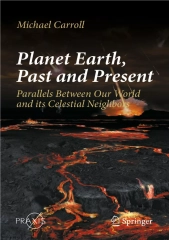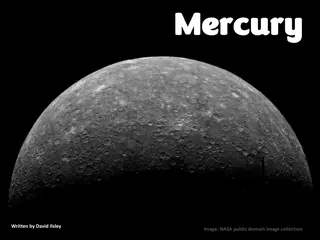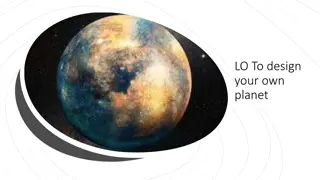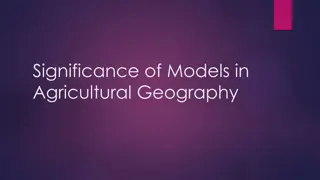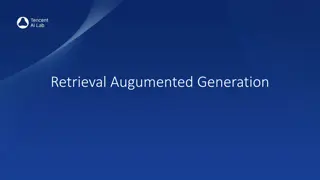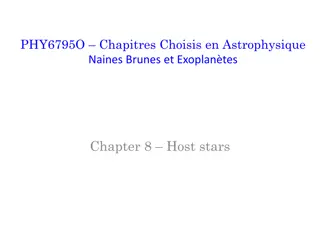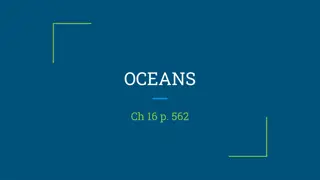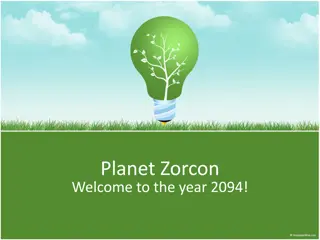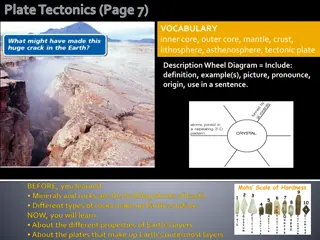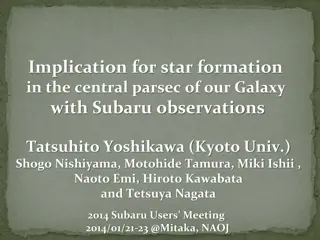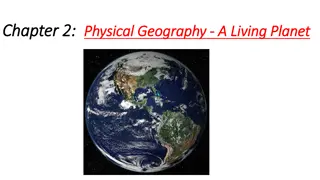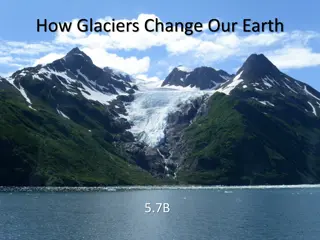Exploring Planet Formation Models
This project by NASA's Jet Propulsion Laboratory and California Institute of Technology focuses on comparing theoretical models of planetary system formation with observational data. Participants will analyze the impact of factors like metallicity, initial disk mass, disk distribution, and gas accretion on the formation of planets. Hands-on sessions will provide tools for research, culminating in group presentations. Choose a group based on specific questions related to protoplanetary disks and planet formation dynamics.
Download Presentation

Please find below an Image/Link to download the presentation.
The content on the website is provided AS IS for your information and personal use only. It may not be sold, licensed, or shared on other websites without obtaining consent from the author.If you encounter any issues during the download, it is possible that the publisher has removed the file from their server.
You are allowed to download the files provided on this website for personal or commercial use, subject to the condition that they are used lawfully. All files are the property of their respective owners.
The content on the website is provided AS IS for your information and personal use only. It may not be sold, licensed, or shared on other websites without obtaining consent from the author.
E N D
Presentation Transcript
National Aeronautics and Space Administration Jet Propulsion Laboratory California Institute of Technology NASA Exoplanet Science Institute Group Projects: Exploring Planet Formation 2015 Sagan Summer Workshop Exoplanetary System Demographics: Theory and Observations July 27, 2015 Sagan Summer Workshop 2015 1
National Aeronautics and Space Administration Jet Propulsion Laboratory California Institute of Technology What is this group project about? Explore planetary system formation by comparing models against observations Hands-on sessions will introduce the tools needed for this research project GlobalPFE: population synthesis model archiveComparison: download & plot real data Choose one of eight different science questions You will sign up for a group on the sheets provided, and start working towards your 7-10 min presentation to be given on Friday afternoon. Deadline to sign up is the mid-afternoon break tomorrow (3:30 Tuesday) NASA Exoplanet Science Institute July 27, 2015 Sagan Summer Workshop 2015 2
National Aeronautics and Space Administration Jet Propulsion Laboratory California Institute of Technology Which group should I choose? Group 1: Metallicity Question: How does the gas-to-dust ratio of the parent protoplanetary disk affect the results from a core accretion population synthesis? NASA Exoplanet Science Institute Group 2: Initial Disk Mass Question: What happens to the number of planets and planet masses if you change the initial mass of a protoplanetary disk? Group 3: Initial Disk Distribution Question: How is the distribution of planet orbits related to the original distribution of the parent disk? Does a steeper disk surface density slope result in more short-period planets? How small does the disk have to be for most gap-opening planets to move outward, rather than inward? Group 4: Gas Accretion Question: How does the assumed physics for runaway gas accretion (e.g. atmosphere opacity) affect the mass distribution for gas giant planets? Do changes in the gas accretion indirectly affect the frequency of gap formation and Type II orbital migration? July 27, 2015 Sagan Summer Workshop 2015 3
National Aeronautics and Space Administration Jet Propulsion Laboratory California Institute of Technology Which group should I choose? Group 5: Embedded-Planet Migration Question: How does the migration speed of embedded planets affect their orbital distribution? What is the ideal amount of migration to create short-period planets, but not have them all fall into their central star? NASA Exoplanet Science Institute Group 6: Gap Formation Question: How does gap formation affect the mass of gas giant planets? How does it affect their orbital distribution, by slowing their migration rate? Group 7: Disk Lifetime Question: How does the disk lifetime affect planet formation? Is there a minimum lifetime required to form Jupiter-like planets? Is there a maximum lifetime to avoid planets all migrating into the star? Group 8: Disk Viscosity Question: Does planet formation depend on the unknown disk viscosity? Can the orbital migration of gap-forming planets be slowed down by adopting a lower disk viscosity? Sagan Summer Workshop 2015 July 27, 2015 4
National Aeronautics and Space Administration Jet Propulsion Laboratory California Institute of Technology What Questions Should I Answer? 1. What question(s) are you trying to answer? 2. What are your hypotheses? 3. What methodology did you use to test your hypotheses? 4. What did you find? 5. What are the implications of your findings? a. Comparison with real data b. Most interesting/surprising result? 6. What conclusions can you draw? 7. What, if any, future work is needed? NASA Exoplanet Science Institute DON T BE AFRAID TO BE CREATIVE!! July 27, 2015 Sagan Summer Workshop 2015 5
Example Template Group Project Slides July 27, 2015 Sagan Summer Workshop 2015 6
Understanding Planet Formation: Disk Color (names and affiliations) July 27, 2015 Sagan Summer Workshop 2015 7
Understanding Planet Formation: Disk Color Project Goal: Understand how planetary systems form and evolve Objective: Use population synthesis models to determine what physics is needed to explain exoplanet observations Science Questions: How does planet formation depend on the disk color? July 27, 2015 Sagan Summer Workshop 2015 8
Understanding Planet Formation: Disk Color Hypothesis (before numerical tests): A redder disk will produce redder planets. Small planets are redder, so these should be favored. Methodology: Vary disk color above and below the nominal value (yellow); try red, orange, green, blue. While disk color is the primary variable of interest, we will also considered some related variables such as disk lightness and saturation, with the ultimate goal of finding the best match to observations. July 27, 2015 Sagan Summer Workshop 2015 9
Understanding Planet Formation: Disk Color Results: We find that the reddest disks do indeed produce the reddest planets. The increase in red planets, however, is not as large as expected. Analysis: In order to compare the simulation against observations of planets detected by radial-velocity surveys, we filter the simulated population with a K=1 m/s filter. We also compared against the Kepler dataset after adding a transit- survey filter. July 27, 2015 Sagan Summer Workshop 2015 10
Understanding Planet Formation: Disk Color Statistical Comparison: As a simple attempt to quantify the success of each model, we performed a K-S comparing the model and observed distributions of semi-major axis and mass. Low values mean there is a low probability that the two distributions are the same. The table below shows log10 values from this test. Disk Color semi-major axis planet mass notes red -90 -55 orange -80 -49 yellow -100 -50 (standard value) green -110 -52 July 27, 2015 blue -130 -43 Sagan Summer Workshop 2015 11
Understanding Planet Formation: Disk Color The simulated distributions never match the observed distribution very well. Still, we find that the simulations of orange disks produce the planet distribution most similar to the observed distribution, particular for the planet orbits (semi-major axis). July 27, 2015 Sagan Summer Workshop 2015 12
Understanding Planet Formation: Disk Color This agrees with our visual assessment of the simulation data (with RV selection effect added) plotted against RV-discovered planets. Standard Model Best Model July 27, 2015 Sagan Summer Workshop 2015 13
Understanding Planet Formation: Disk Color Conclusion: Inclusion of new physics into standard models of planet formation disk color effects allows for a better match to exoplanet observations. In particular, the semi-major axis distributions are now consistent with each other. While this new model offers a solution for the formation of red and blue sub-Jupiters, there is still no good theoretical explanation for the distribution of brown super-Neptunes detected by microimaging. Future work: Variation of disk shape (square, triangle) may help to explain some of the remaining discrepancies, such as the lack of purple short-period exoplanets within the models. July 27, 2015 Sagan Summer Workshop 2015 14
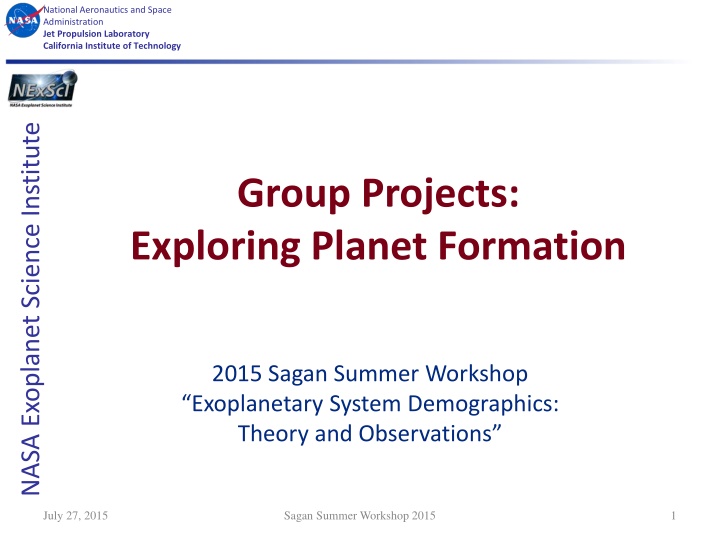

![[PDF⚡READ❤ONLINE] Neptune: The Planet, Rings, and Satellites](/thumb/21522/pdf-read-online-neptune-the-planet-rings-and-satellites.jpg)
![[PDF⚡READ❤ONLINE] Planet Mercury: From Pale Pink Dot to Dynamic World (Springer](/thumb/21549/pdf-read-online-planet-mercury-from-pale-pink-dot-to-dynamic-world-springer.jpg)
